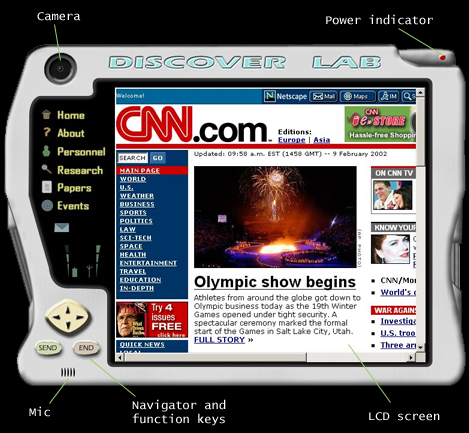|
|
|
|
|
|
|||
|
The Laboratory of Digital Signal Compression & V
ideo E
ncoding Research, or DISCOVER Lab for short, is a research facility
originally founded for video/audio compression algorithm development aiming at elevating worldwide workstation video capability to the status of a standard utility. When DISCOVER Lab was founded in 1994 by Prof. Throughout the years though, the lab has also come to embody the broad research areas pursued by
Prof. Berger's past and present students. These include research on information theory, communication networks, wireless sensor networks, human signature verification, speaker verification, various aspects of IEEE 802.11
wireless networking, open source development of our video conferencing software on the Linux platform, wireless enabling and deployment of these systems on handheld computing devices, etc. For details on past and
present research projects, please see below and sections under " |
|||
|
|
|
|
|||||||||||||||||||||
|
It is based on the paper A Software-Only Videocodec using Pixelwise Conditional Differential Replenishment and Perceptual Enhancements by Yi-Jen Chiu and Toby Berger and their patent "Facsimile-Based Video Compression". Using spatio-temporal compression techniques for perceptual coding, the algorithm is able to capitalize on properties in the human visual system to greatly improve the tradeoff between data rate, picture quality, computational complexity and latency. Contrasting with traditonal algorithms that adjust the quantization factors in frequency domain compression to temporarily provide lower-quality pictures during network congestions or intense object movements, our scheme restrain bitrate by compressing picture information in ways that are visually indistinguishable to human perception.Because of that, CU30 is currently the only software-only video codec that provides full-duplex, full color, high quality Q-NTSC at full 30 fps on PC's. Its latest version also incorporates fruitions of various R&D efforts from past years, such as object tracking, motion compensation and codebook generation techniques. Development of a MS Windows based video conferencing software that applies CU30 has constantly been our main research and development focus. In recent years, we have also successfully started a parallel development on the Linux platform with an open source project called the CU30 project (no longer maintained now). Most recently, DISCOVER Lab also initiated projects to develop video conferencing applications on single board computers and handsets over Qualcomm's BREW platform.During 2001, the OpenH323 project that is developing an open source implementation of the H.323 protocol suite has opted to include our CU30 codec. Thus, if the OpenH323 shell library detects the CU30 codec in a system, it will be enabled to use CU30 for video encoding with other OpenH323 applications. One such example is a free software called GnomeMeeting that is designing a H.323 compatible client (a clone of MS NetMeeting) for the Gnome desktop. Note that the OpenH323 project is currently still on-going and under development.
The CU30 algorithm is covered under US patents No. 5,740,278 and 5,973,626. For more details on projects related to CU30, please visit the " Research" section.
|
|||||||||||||||||||||
|
|
|
|
|||
|
Besides the aforementioned, DISCOVER Lab was also involved with inventing the following patents: 1. U. S. Pat. No. 5,091,975, 382/3,56,21;
358/261.3; 902/22; 364/405;235/378 A Method and Apparatus for On-Line Compression of Human Signatures, Assignee: Teknekron Communications Systems, Inc. Issued 1992. Co-inventors, Toby Berger and Daniel Miller. 2. U. S. Pat.
No. 5,559,895, Adaptive Method and System for Real TimeVerification of Dynamic Human Signatures, Assignee: Cornell ResearchFoundation. Issued 24 September, 1996, Co-inventors, Toby Berger and Luan-Ling Lee. 3. U. S. Pat. No.
5,740,278, Facsimile-Based Video Compression Method and System, Assignee: Cornell Research Foundation. Issued 14 April 1998, Co-inventors, Toby Berger and Yi-Jen Chiu. 4. U. S. Pat. Application 09/042,509, Byte-Based Prefix
Encoding,Assignee: Cornell Research Foundation: Practitioner's Docket No. CRFD-2040. Approved May 10, 1999, Co-inventors, Toby Berger, Yi-Jen Chiu and Mikio Kawahara. |
|||
|
|
 |
|
To provide our viewers with a variety of experience interacting with our "handheld browser", below are some links that will bring up their corresponding websites on the "LCD screen". Happy surfing! |
|
|
|
|
|
|
All graphics unless specified below, uncredited photos, and design of this website are original work of Douglas Chan. All
copyrights belong to DISCOVER Lab. Icons near the bottom of |
|
|
|
|
|||||||||
 |
|||||||||
|
|
|||||||||
|
|
|||||||||
|
©Copyright 2001-2004 DISCOVER Lab |
|||||||||